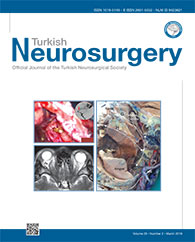2Medipol University, Department of Neurosurgery, Istanbul, Turkey
3Biruni University, Department of Neurosurgery, Istanbul, Turkey DOI : 10.5137/1019-5149.JTN.24714-18.1 AIM: To compare the results of lumbar puncture (LP) and shunt tapping in pediatric patients with suspected ventriculoperitoneal shunt infection.
MATERIAL and METHODS: Medical records of pediatric patients with suspected shunt infections were retrospectively analyzed. All patients had cerebrospinal fluid samples obtained either via shunt tapping, LP or both. The diagnosis of infection was made when at least one cerebrospinal fluid had positive culture results. The patients with negative cerebrospinal fluid culture results were followed up for at least 6 months to monitor the occurrence of central nervous system infection.
RESULTS: There were 20 patients in the study (12 males, 8 females). Cerebrospinal fluid was obtained by shunt tapping in 11, by lumbar puncture in 9 and by both methods in one patient. Thirteen patients [ Shunt tapping: 5/11 (45%), LP: 7/9 (78%), Both: 1) ] were diagnosed with shunt infection on the basis of cerebrospinal fluid culture. Seven patients with negative cerebrospinal fluid culture were found to have infections unrelated to shunts and did not show evidence of cerebrospinal fluid infection during the follow-up period. Although the percentage of detecting the infection was higher in LP group, both groups showed negative predictive value of 100%.
CONCLUSION: Both shunt tapping and LP are effective in establishing the diagnosis of shunt infection in suspected patients.
Keywords : Shunt, Infection, Lumbar puncture, Cerebrospinal fluid




